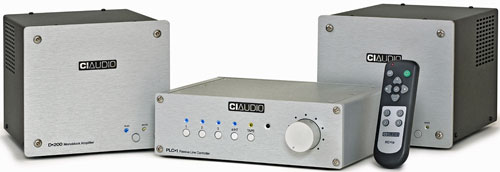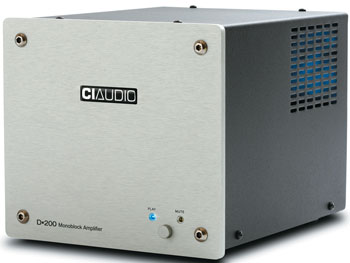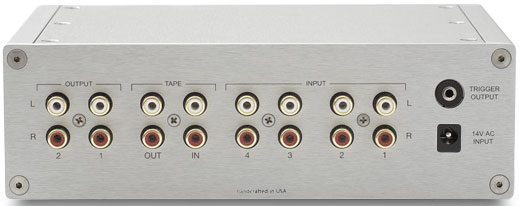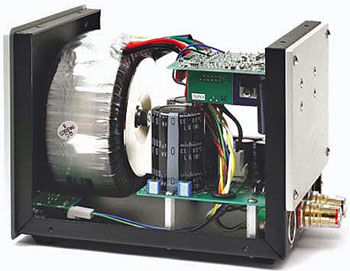I’ll never forget the day I saw a picture of a “pocket poodle*.” How small can a dog get? It amazed me how far miniaturization has been taken. No less amazing is how tiny electronics have become. I remember very well my father’s Heathkit separates which he lovingly built and how the preamp/tuner and amp occupied a reasonable piece of real estate on the living room bay window ledge.
The components reviewed here, the Channel Islands PLC-1 Passive Line Controller, and the D-200 Class D Monoblocks, would have all fitted comfortably within the dimensions of the Heathkit amp alone. While beasty multi-channel surround receivers are all the rage with the general population, more discriminating listeners now can find gear to fit not only their budget but virtually any space. Maybe there should be a new category of components considered “size no object”! Their small size would require a new smaller standard of cabling and connectors. It’s already happened with portables, why not with home components?
Dusty Vawter, founder of Channel Islands Audio, have a penchant for diminutive products. Eschewing the philosophy that audio gear must be large, they held to a smaller chassis, shorter signal path and reduced pricing. One gets the sense that in the Channel Islands world, interior real estate is precious and not to be wasted. Many audiophiles’ wives will take one look and agree, as will anyone who wants quality components in a smaller living space.
The dimensions of Channel Island equipment border on diminutive as most are under 5”w x 3”h x 5”w! The “scaled up” D-200 monos are hardly a horizon blocking affair, at 6.25”w x 5.5”h x 8”d. It is comical to see the disparity between the D-200’s compared with the formidable-looking Dussun V8i, a 70lb. solid state integrated. But, it’s in the listening where the PLC-1 and D-200’s carve out their space. Would this bookshelf-sized passive pre/amp combo play larger than its size? To find out, I paired them with some pretty hefty performers.
The remote-controlled PLC-1 is a new offering bringing a host of features including five inputs (the fifth is for tape monitoring), Home Theater bypass (enabled by use of a hex wrench supplied to enter the unit and move a blue jumper pin to the “HT Bypass On” position), tape input/output, and a 12v trigger. Channel Islands builds with the philosophy that utilizing the signal of a source to drive an amp directly, eliminating the second gain stage (in active preamps), removes distortions and colorations from the music. The PLC-1 uses a custom ALPS® Blue Velvet motorized potentiometer, and the signal switching relays have gold-plated contacts; this is not a cheaply constructed preamp.
The appearance of the PLC-1 is unobtrusive in every respect, a reserved component which looks contemporary and a bit scientific. A smart row of blue LED’s light up corresponding to the input, i.e. three lit for input 3. A similar amber LED indicates tape monitoring. Power is supplied via a 14v AC converter, similar to small electronics such as hand-held game machines.
FLIGHTS OF FANTASY (a listening moment): Pablo Cruise Worlds Away, “Runnin’” was a return to a group I enjoyed in the 70’s. The recording, as aged as it was, perked up with the Channel Islands gear, precise but not plasticky sounding. While it’s so difficult to measure component quality with synthesized sounds, one can definitely determine the clarity of the synthesizer. Here it was rendered in an almost three-dimensional form similar to an acoustic instrument. The use of the passive line stage with the D-200 Class D amps kept the sound from being haziness-amplified to the Nth degree.
“Sailing Away”, has four-part harmony which is rather indistinct, again due to the recording. The PLC-1 retrieved the vocals in a most satisfactory fashion. If a person has quite a number of older discs where vocals are prominent, then I would suggest mating the PLC-1 and D-200’s with a warmer sounding CD player, since the Channel Islands gear will bring plenty of focusing power and one does not want the signal to being amplified to sound thin.
I asked Dusty about the converter as the power supply for the PLC-1. His response was that the PLC-1 is a truly passive component as regards the signal path; there is no need for an IEC as in an active preamp. The power supply is used only to run the microcontroller and remote control functions. This means that audiophile quality signal treatment can be combined with remote control convenience.
The “smaller is beautiful” philosophy applies to the RC-1 remote as well. It’s tiny enough that it might benefit from a GPS chip in case it is lost in an overstuffed sofa! Yet, it is perfectly laid out to accommodate commands for inputs (including scrolling up or down or direct input), volume, mute, 12v Trigger and Tape Monitor. A red “transmit” LED indicates that commands are being issued. An overall clean and ergonomically efficient design, although not backlit, I found it intuitive to use in dim light.
The D-200’s are “featherweights” as class D amps, with minimal acreage in back to accommodate the IEC receptacle, gold plated speaker binding posts, and a single-ended input (Note: A balanced XLR version of the amp is also available!). Even with such little room to maneuver I did not find the arrangement cramped. Due to the limited space on the back side, a purchaser must choose between balanced or single-ended intput, however Dusty pointed out that the amp circuit is truly balanced, so that one can buy the XLR version and use Cardas/Nuetrik adapters to run the amps single-ended. The amps also come with either 32db gain for use with the PLC-1, or 26db gain for active preamps. To date, Channel Islands has not charged for adjusting the gain even on second hand or “out of warranty” product.
The D-200’s use a modified Hypex UcD400 module, chosen for it’s flat frequency response regardless of load and the absence of floating DC on the output signal. A split-rail power supply ensures that the amps will be compatible with all subwoofers, including ones that use a speaker level input. Extremely accurate and uncolored, the class D amps have lower power consumption and less production costs, resulting in improved lifespan and reliability.
Another fine quality of the D-200’s is that they consume so little energy that one can leave them in standby mode indefinitely. Admirably, they do not produce the dreaded obnoxious popping sound when turned on or off. I have a Naim Nait 5i integrated in my office, a truly fine component, but I cannot stand “the pop” when it’s powered on or off. My feeling is that a truly fine design should be able to eliminate such basic operational abnormalities.
Speaking of acoustic abnormalities, the D-200’s sent to me were in pristine condition, however, they emitted an low pitched hum even when in standby mode. An auidiophile DIY friend who heard them insisted it was a physical vibration and laid the blame at the feet of the transformers. Dusty felt it was a DC problem on my electrical lines, so he sent me one of Channel Islands new XDC-2 AC Filters. The CIAudio website explains the fix, “Even a small amount of DC riding on your AC line can saturate the transformers core, causing excessive mechanical hum or buzz. Inserting the XDC-2 between the AC source and noisy component is the solution…by blocking the DC, the transformer works more efficiently, improves the sound of the audio component, and eliminates the DC induced hum.” So, it did involve the transformers and the XDC-2 seemed to be the answer.
- (Page 1 of 2)
- Next page →





